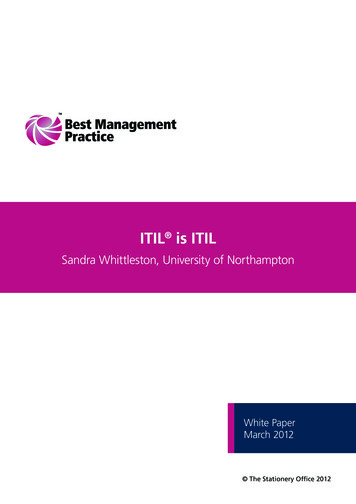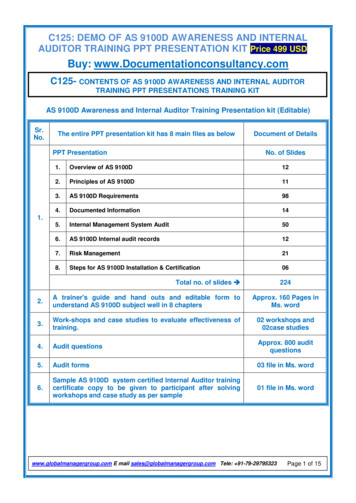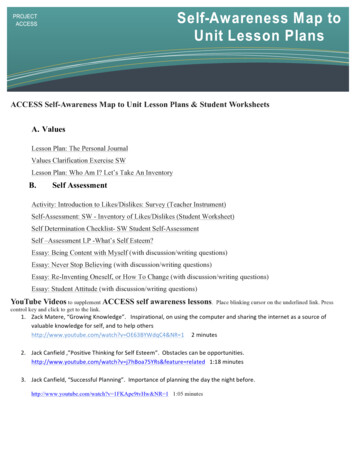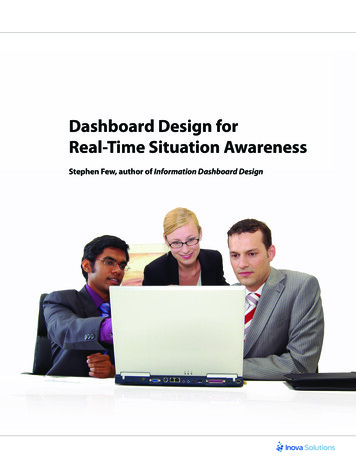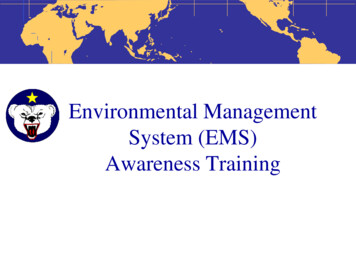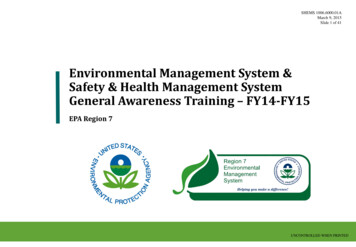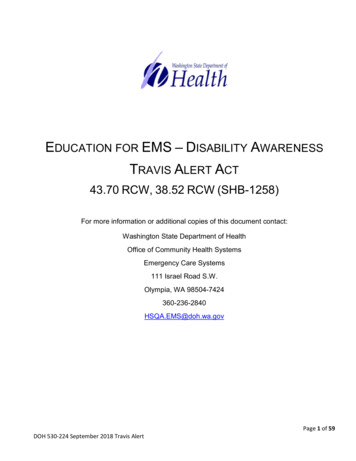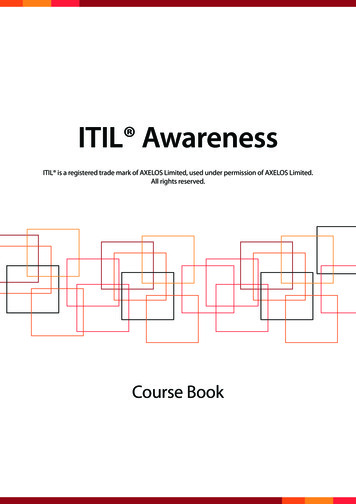
Transcription
ITIL AwarenessITIL is a registered trade mark of AXELOS Limited, used under permission of AXELOS Limited.All rights reserved.Course Book
Copyright and DisclaimerITIL Awareness r2.0.0CopyrightCopyright AXELOS Limited 2017. All rights reserved.This is a commercial confidential publication. All rights reserved. This document may not, in a whole orin part, be copied, reproduced, translated, photocopied, or reduced to any medium without prior andexpress written consent from the publisher.This course includes copyrightable work under license and is protected by copyright. No part of thispublication may be reproduced, distributed, or transmitted in any form or by any means, includingphotocopying, recording, or other electronic or mechanical methods, without the prior written permissionof the publisher, except in the case of brief quotations embodied in critical reviews and certain othernoncommercial uses permitted by copyright law or further disseminated without the express and writtenpermission of the legal holder of that particular copyright. The Publisher reserves the right to revokethat permission at any time. Permission is not given for any commercial use or sale of this material.Trade Marks, Source books informationITIL is a registered trade mark of AXELOS Limited, used under permission of AXELOS Limited.The Swirl logo is a trade mark of AXELOS Limited, used under permission of AXELOS Limited.The ITIL Accredited Training Organization logo is a trade mark of AXELOS Limited, used underpermission of AXELOS Limited.IT Infrastructure Library is a registered trade mark of AXELOS Limited, used under permission ofAXELOS Limited. All rights reserved.No part of this document may be reproduced in any form without the written permission of AXELOSLimited. Permission can be requested at licensing@AXELOS.com.Material in this document has been sourced from ITIL Service Lifecycle Suite 2nd Edition, 2011.Copyright AXELOS Limited 2011.DisclaimerInformation provided about the course, modules, topics and any services for courses includingsimulations or handouts, are an expression of intent only and are not to be taken as a firm offer orundertaking. The Publisher reserves the right to discontinue or vary or maintain such course, modules,topics, or services at any time without notice and to impose limitations on enrolment in any course.The course materials provided may have hypertext links to a number of other web sites as a referenceto users. This service does not mean that the publisher endorses those sites or material on them inany way. The publisher is not responsible for the use of a hypertext link for which a commercial chargeapplies. Individual users are responsible for any charges that their use may incur.The information in this course is written using a blend of British and American English. Althoughevery effort has been made regarding the usage of correct spelling, punctuation, vocabulary, andgrammar with regard to the Standard English, the publisher accepts no responsibility for any loss orinconvenience caused due to the regional differences in the usage of the English language.ii Copyright 2017Sample Material - Not for Resale
ContentsAcknowledgements ivModule 11Course Learning ObjectivesCourse OutlineCourse OverviewConcept of ITIL and ITSMServiceService ValueValue to Customers: Utility and WarrantyService ManagementDefining IT Service ManagementIntroducing Stakeholders in Service ManagementHow ITSM Reduces Costs and Improves the Quality of IT Services?What is ITIL?Why Adopting ITIL?ITIL: Value PropositionITIL Processes Within the Service Lifecycle ContextWhat is Process?How Does Process Model Work?Introducing FunctionsDifferent Functions and its Emphasis on Service LifecycleThe RACI ModelActivity: QuizITIL Service Lifecycle Approach to ITSMITIL Service LifecycleHow Does ITIL Service Lifecycle Process?Activity: QuizRoles and Responsibilities in ITILRoleGeneric RolesGeneric Process RolesActivity: QuizHow ITIL Roles Can Fit Together Within The Service Lifecycle?ITIL Certification SchemeThe ITIL Certification Scheme OverviewITIL Credit AssignmentHow ITIL Fits With Other Frameworks and Practices?Recap ExerciseModule 8181819192021Appendix A: Answers to Activities: Quiz23Appendix B: Release Notes27Appendix C: Participant Feedback Form29Sample Material - Not for ResaleCopyright 2017 iii
AcknowledgementsWe would like to sincerely thank the experts who have contributed to the development of theITIL Awareness.Lead AuthorMarcel FoedererAs an IT Service Management trainer, consultant and line manager withover 25 years experience in IT, Marcel has performed strategic and tacticalassignments in a wide variety of areas.His experience includes project and program management including processdesign, product management, requirements analysis and training deliveryrelated to the IT Service Management international best practice, in both theprivate and public sectors on a global scale. His area of consulting expertiseis in advising organizations on IT Service Management, based on ITIL (ITInfrastructure Library) best practices, and in the management of these initiativesto improve organizational and operational efficiencies and service deliveryquality. He also excels as an experienced facilitator, trainer and lecturer. Heis committed to the successful delivery of total solutions to his client base,achieved through respect for the management of change issues involved inthe resulting integration of people, process and technology.iv Copyright 2017Sample Material - Not for Resale
1Course Learning ObjectivesAt the end of this course, you will be able to:Describe the concept of service and Service Management.Describe the concept of ITIL and ITSM.Explain the benefits of implementing ITIL in an organization.Describe the importance of functions and processes in anorganization.Describe how ITIL processes map to the overall servicelifecycle.Define the roles and responsibilities involved with the servicelifecycle.Explain the ITIL Certification scheme and its correspondingcredits system.Course OutlineCourse OverviewThe ITIL Awareness course provideslearners with the unique opportunityto receive an introduction to theconcepts of IT Infrastructure Library(ITIL) and IT Service Management(ITSM). It provides an overview of theconcepts within the ITIL best practicesdomain while also introducingthe key ITIL processes. This courseexplains how ITIL processes aredriven by a service lifecycle to providesmooth functioning to organizations,thus ensuring high-quality servicesto their customers.Concept of ITIL and ITSMITIL Processes Within the Service Lifecycle ContextITIL Service Lifecycle Approach to ITSMRoles and Responsibilities in ITILITIL Certification SchemeSample Material - Not for ResaleCopyright 2017 1
Course Book ITIL AwarenessConcept of ITIL and ITSMService“Service: A means of delivering value to customers by facilitatingoutcomes customers want to achieve without the ownership ofspecific costs and risks.”Quoted text Source is ITIL Service Lifecycle Suite 2nd Edition, 2011. Copyright AXELOS Limited 2011. Material is reproduced under licence from AXELOS Limited.All rights reserved.Services are a means to deliver value to customers by enablingwhat the customer wants to achieve (outcomes) without taking anyownership of costs and risks. All services have a service cost whenthey become operational, which is reflected as ROI and Total Cost ofOwnership (TCO), and this cost must be managed. To avoid takingROI and TCO risks, customers look to service Providers to satisfytheir need for those services. The service provider, on the otherhand, provides those services according to the requirements of thecustomers.Service Value The value of a service is defined by the customer who receivesor uses the service and not by the service provider. A customer selects the service that has the best mix offeatures and functionality, based on their requirements.Based on AXELOS ITIL Service Lifecycle Suite 2nd Edition, 2011 material.Reproduced under licence from AXELOS Limited. All rights reserved.Service ProviderService providers refers to anorganization supplying servicesto one or more internal customersor external customers. Serviceprovider is often used as anabbreviation for IT service provider.2 Copyright 2017The main purpose of a service provider is to create value for itscustomers with its services. The value of a service is defined by thecustomer who receives or uses the service and not by the serviceprovider. The customer decide what outcomes and objectives they willachieve by utilizing the service. The vital conclusion as to whether aservice is valuable or not is decided by the customer.The value is an affordable mix of features. A customer selects theservice that has the best mix of features and functionality, based ontheir requirements, and at the price they are willing to pay.Sample Material - Not for Resale
andSMValueto theCustomers:UtilityUtility iswhatcustomergetsandandWarrantyWarranty is how it is delivered.Utility is what the customer gets and Warranty is how it is delivered.UtilityFit for Purpose – the functionalityoffered by a product or service tomeet a particular needConstraintsRemoved?Fit for PurposeT/FWarrantyFit for Use – a promise or guaranteethat availability, capacity, continuity,and security are all meeting cleSMandTILCourse Book ITIL AwarenessORsesiceextValue to Customers: Utility and WarrantyValue CreatedT/FFit for UseT/FSecureEnough?Utility Warranty ValueBased on AXELOS ITIL Service Lifecycle Suite 2nd Edition, 2011 material.Reproduced under licence from AXELOS Limited. All rights reserved.Based on AXELOS ITIL Service Lifecycle Suite 2nd Edition, 2011 material. Reproduced under licence from AXELOS Limited. All rights reserved.The customer’s perception of value can be described through theconcepts of Utility and Warranty. A business will obtain greater valuefrom services that operate more efficiently and effectively (Utility) andwith greater reliability (Warranty).Copyright 2017 7The Utility is achieved when a service (or parts of service) deliver apositive effect on performance associated with the desired outcome.This can include the removal or relaxation of performance constraints.The Warranty is achieved when the service is available at the timewhen it is required and in sufficient capacity and dependability.Activity:Group DiscussionDifference between “Fit for Purpose” and “Fit for Use”Give some examples where a product or service is “Fit for Purpose”but not “Fit for Use”.Service Management“Service Management: Is a professional practice that is globally supported byqualification schemes and standards. Must transform capabilities and resources into valuableservices.”Quoted text Source is ITIL Service Lifecycle Suite 2nd Edition, 2011. Copyright AXELOS Limited 2011. Material is reproduced under licence from AXELOS Limited.All rights reserved.Sample Material - Not for ResaleCopyright 2017 3
Course Book ITIL AwarenessDefining IT Service ManagementDefining IT Service Management“IT Service Management(ITSM):The implementationand managementof quality“IT ServiceManagement(ITSM): The meettheneedsoftheIT Services that meet the needs of the business. IT service management is performedservice managementis performedIT Serviceby IT Service business.ProvidersIT throughan appropriatemix of bypeople,process andProviders through an appropriate mix of people, process andinformation technology.”TIL andITSMinformation technology.”ocessesServiceContextLifecycleto ITSMoles ands in ITILtificationSchemeTipsThe meaning of IT keeps changingdepending on the various perspectivesof the business and people. As aresult, these perspectives needto be recognized and balanced tocommunicate the value of ITSM andknow the context of how the businesslooks at the IT organization.ITSMIT SERVICE RTQuotedtextSourceITIL ServiceSuite2ndis reproducedEdition, 2011.Copyright Quoted text Source is ITIL Service LifecycleSuite 2ndEdition,2011.isCopyright AXELOSLifecycleLimited 2011.Materialunder licencefrom AXELOSLimited.All rights reserved.AXELOS Limited 2011. Material is reproduced under licence from AXELOS Limited. All rights reserved.Food for ThoughtTry to provide some more examples ofService Management frameworks.Some meanings of ITSM are: “IT is a collection of systems, applications and infrastructureswhich are components or sub-assemblies of a larger product.They enable or are embedded in processes and services. IT is an organization with its own set of capabilities andresources. IT organizations can be of various types such asbusiness functions, shared services units and enterprise-levelcore units. IT is a category of services utilized by business. The servicesare typically IT applications and infrastructure that arepackaged and offered by internal IT organizations or externalservice providers. IT costs are treated as business expenses. IT is a category of business assets that provide a stream ofbenefits for their owners, including, but not limited to, revenue,income and profit. IT costs are treated as investments.”Quoted text Source is ITIL Service Lifecycle Suite 2nd Edition, 2011. Copyright AXELOS Limited 2011. Material is reproduced under licence from AXELOS Limited.All rights reserved.4 Copyright 2017Sample Material - Not for ResaleCopyright
ITIL Awareness Concept of ITIL and ITSM ITIL Processes Within the Service Lifecycle Context ITIL Service Lifecycle Approach to ITSM Roles and Responsibilities in ITIL ITIL Certification Scheme Utility is what the customer gets and Warranty is how it is delivered. Value to Customers: Utility and Warranty warranty Fit for use – a promise or guarantee

